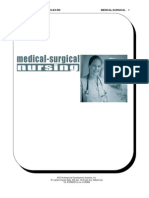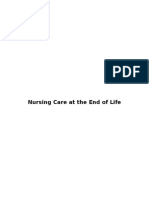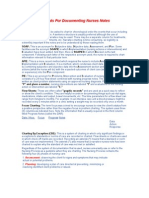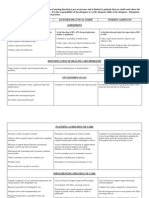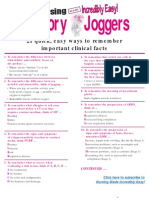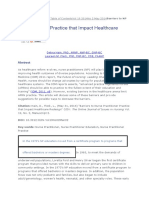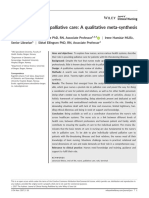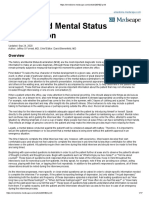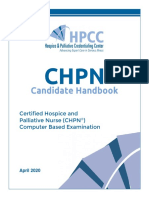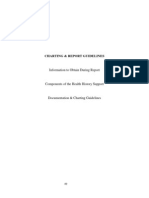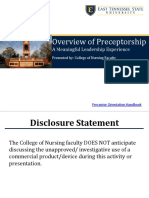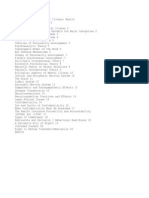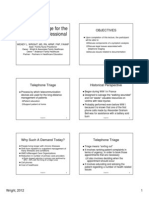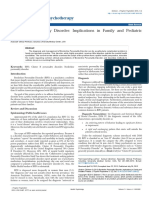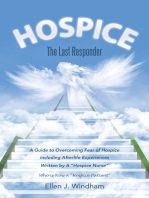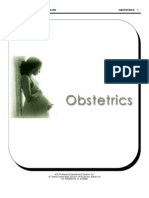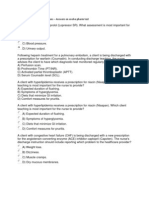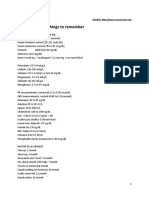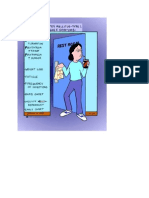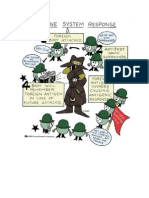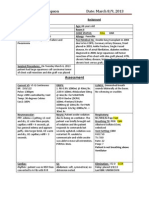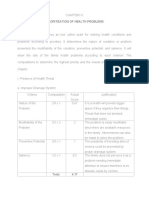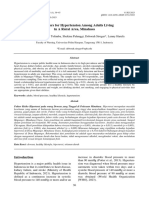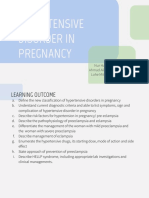Hospice Care Plan
Hospice Care Plan
Uploaded by
Amanda SimpsonCopyright:
Available Formats
Hospice Care Plan
Hospice Care Plan
Uploaded by
Amanda SimpsonOriginal Description:
Copyright
Available Formats
Share this document
Did you find this document useful?
Is this content inappropriate?
Copyright:
Available Formats
Hospice Care Plan
Hospice Care Plan
Uploaded by
Amanda SimpsonCopyright:
Available Formats
TCC Nursing Program NURS 2543 Nursing Promotion for Quality of Life
Hospice Patient/Family Data Sheet
1. Past Medical History and reason for Hospice care
2. Family/Caregiver Structure
3. Describe Environment
TCC Nursing Program NURS 2543 Nursing Promotion for Quality of Life Functional Health PatternsSubjective and Objective Data Health Perception Health Management: The client was admitted and is maintained on hospice due to the current diagnosis of rectal cancer which is terminal. Patient is a 75 y/o African American female. The client also has a diagnosis of dementia. The patient youngest daughter is her live in primary caregiver. The primary caregiver takes the patients to all of her appointments in addition to ensuring that the patient gets her medications as ordered. The patients caregiver stated that healthcare providers have done as expected and she is currently happy with the level of care her mother receives. Nutrition Metabolic: Pt. caregiver states pt.s appetite is poor to fair. He patient stated that she does not have any problems with chewing or swallowing. The patient does wear dentures and did not have them in her mouth during the assessment. Mucous membranes are pink, moist and intact. Patient has recently been suffering from nausea but vomiting has not presented itself at this time. Patients caregiver states that the patient has lost at total of 7 pounds in the last 30 days. Oral temperature 97.9 degrees Fahrenheit. Skin was warm and dry with yellow undertones. Skin was intact, no open sores noted. Heels of both feet were spongy but intact. Patient takes Megace as an appetite stimulant. Activity-Exercise: Patient can move around fairly easy with mild assistant when first getting out of bed in the morning. Patient does not smoke, and has mild shortness of breath on exertion, patient states that it was tolerable and that she was not experiencing any shortness of breath at this time. Patient has a congestive heart failure; pt. states that she is not currently having cardiac pain nor has she experienced any recently. Lungs were CTA; respiratory rate of 18 breaths per minute visually, no cough present at this time. Apical heart rate 86 beats per minute and was irregular in rate and rhythm. Edema present in lower extremities bilaterally and was not pitting. Lower extremities were warm and dry Cognitive Perceptual: pt. has PERRLA, was oriented to person and place, patient does not use hearing air or glasses, wears dentures, hearing is slightly diminished. Patient denies having pain; patient does not reveal any consciousness of memory changes but caregiver states that there have been moderate memory changes in the last 6 months. Patient demonstrated awareness of body parts. Education level was not addressed.
Self-Perception -Self-Concept: Questions about the patients self and abilities were not answered by the patient for lack of time. Illness has affected the patients physical mobility and the ability to participate in once meaningful interactions. The patient is limited to contact with the youngest daughter with occasional visits from her other 7 children. The patient is no longer to independently shop for herself or prepare her own meals. The patient was relaxed and lying in bed, unguarded behavior. Unable to assess geriatric depression using standard measuring the tool due to the lack of time. Role Relationship: The patient who is a mother of 8 grown children is now being cared for by her youngest child. The youngest child is now the primary caregiver. Patient was a homemaker. The patient is no longer available to do things as independently as she did before the beginning of the disease process and she is unable to live by or care for herself. The daughter seemed distant while hospice was with the patient; she answered questions but appeared to be very tired. I visualized no interaction between the daughter and the patient.
with patches of hair present. Pedal pulses were present and palpable. Blood pressure 193/89. Capillary refill less than 3 second in upper and lower extremities. Negative Holmans sign, strength in upper and lower extremities was equal bilaterally. Patient uses a rolling walker outside of the home. Patients caregiver states that the patient easily tires when completing simple tasks and naps frequently. Elimination (urinary/bowel): Patient stated that she has problems urinating with a major complaint of pain in her lower back and some hesitancy as well as a decrease in the amount of urine she passes. Functional incontinence with bowel and bladder. Caregiver states that the patient does not drink much because she is not thirsty. Last BM 9/18/12 which was soft, semi formed and dark brown. Patient does not take any stool softeners or laxatives because she states that most of her stools are soft or liquid. Abdomen was soft and non-tender, bowel sounds were active in all quadrants, no pain or discomfort upon palpation, no bulges or masses felt. Care giver states the use of briefs at night and during the day due to the functional incontinence. Sleep-Rest: Patient has no specific sleep patterns due to the variance because of daytime sleepiness and frequent naps. Caregiver states that the patient lays down beginning at 10pm and rises from bed around 10am. Main factors that influence sleep are frequent daytime napping and diarrhea during the night. Upon my assessment of the patient is visibly clear that she was tired, eyes were swollen with dark circles underneath and was frequently yawning. Patients attention span was short. Sexuality-Reproductive: Patient is and presents herself as a female, she wears make up and wears dress clothes specific to a woman. Patient gets yearly mammograms. All others sexual/reproductive patterns were not addressed.
Coping-Stress-Tolerance: Patient denies any use of alcohol or illegal drugs. Support systems consist of children not all of which participate in her care. Lack of eye contact. Patient had a bright affect. Patient denies having anxiety. No specific coping mechanisms or stressors noted.
Value-Belief: Patients home was decorated with religious items, a picture of the last supper, a picture of Jesus, crosses, a crucifix on the wall in the bedroom and a bible on the bedside table. Patient has a DNR. Questions regarding specific religious beliefs were not asked due to the lack of time.
TCC Nursing Program NURS 2453 Nursing Promotion for Quality of Life Hospice Medication List Med/Route, Frequency, Dosage Normal Dose Range 1) Classification, 2) Action 3) Reason Rxd for THIS Client 1) Nursing Precautions 2) Common Side Effects, 3) Nursing Implications Clients Response to Medication
Date Started
TCC Nursing Program NURS 2453 Nursing Promotion for Quality of Life
Working Copy
Nursing Diagnosis Knowledge deficient Supporting Data Key learning need (Hospice) Management of hypertension history of non-compliance Meds Meds Nursing Diagnosis Risk for caregiver role Strain (daughter) Supporting Data
Labs
Labs
Nursing Diagnosis Ineffective health maintenance Supporting Data
Meds
Client/Family 75 y/o African American female with a Hospice diagnosis of rectal cancer. Daughter is primary caregiver Reason for Needing Hospice: Rectal Cancer Key Assessments:
Nursing Diagnosis Chronic confusion Supporting Data
Meds
Labs Labs
Nursing Diagnosis Risk for electrolyte imbalance Supporting Data
Nursing Diagnosis: risk for ineffective GI tissue perfusion Supporting Data
Nursing Diagnosis: decreased cardiac tissue perfusion Supporting Data
Meds
Meds
Meds
Labs
Labs
Labs
TCC Nursing Program NURS 2453-Nursing Promotion for Quality of Life Teaching Plan Nursing Diagnosis Goal ____________________________________________________________________________________ Content Reference: ____________________________________________________________________________ Learner Objectives Caregiver will demonstrate understanding of the teaching content by verbalizing what blood pressure is, why compliance to the medication regime is necessary and potential complications to not complying with medication regime. Met Content 1. Provide the numeric value of the patient's BP and explain what it means (e.g., high, low, normal, borderline). Encourage patient to monitor BP at home and instruct the patient to call health care provider if BP exceeds high or low limits set by health care provider. Normal BP <120 and <80 Prehypertension 120-139 or 8089 Hypertension, stage 1 140-159 or 90-99 Hypertension, stage 2 160 or 100 (Lewis, Sharon. Medical-Surgical Nursing (with Media), 8th Edition. Mosby p. 741). 2. Inform the patient that hypertension is usually asymptomatic and symptoms (e.g., nosebleeds) do not reliably indicate BP levels. 3. Explain the potential dangers of uncontrolled hypertension. The most common complications of hypertension are target organ diseases occurring in the heart (hypertensive heart disease), brain (cerebrovascular disease), peripheral vasculature (peripheral vascular disease), kidneys (nephrosclerosis), and eyes (retinal damage) (Lewis, Sharon. Medical-Surgical Nursing (with Media), 8th Edition. Mosby p. 743). 4. Caution the patient not to stop Clonidine abruptly because withdrawal may cause a severe hypertensive reaction. Sudden discontinuation may cause withdrawal syndrome including rebound hypertension, tachycardia, headache, tremors, apprehension, and sweating. Teaching Strategy I would provide the caregiver verbal instruction as well as provide her with supplemental information in handout form if needed. I would use open ended questions and therapeutic communication.
TCC Nursing Program NURS 2453 Nursing Promotion for Quality of Life Evaluation of the Teaching
The chief learner in this teaching plan is the daughter who is the primary caregiver. Client has poor health management due to non-compliance with hypertension medication regime, I believe due to a knowledge deficit. I did not identify any readiness to learn from the caregiver but she did act surprised when the blood pressure maintains a range in the 190s systolic and in the 90s diastolic. Teaching would be held in an intimate and non-threatening part of the common such as the family room. In this instance I would choose not to include the patient in the teaching lesson simply due to the fact that the caregiver provides the daily medication to the patient. I would sit across from the caregiver and maintain non-threatening eye contact. I would include basic information regarding hypertension; material would be at a 6th grade level or less. First I would assess the knowledge of the caregiver on hypertension; judging by what she did or did not know I would tell her that blood pressure is the force exerted by the blood against the walls of the blood vessel. I would educate the caregiver that hypertension is more aggressive in African Americans and results in more severe end-organ damage. (Lewis, 2011) I would inform her that hypertension is known as the silent killer because it commonly presents with no signs and symptoms and that while the patient states she is fine she still needs to continue taking the prescribed medications. I would educate the caregiver to not to stop drugs abruptly because withdrawal may cause a severe hypertensive reaction (rebound hypertension). (Lewis, 2011) After the caregiver teaching was complete and throughout the teaching I would evaluate the caregivers understanding of the information given. I would evaluate caregivers understanding by
having her repeat the information learned. I would ask her if she understood the information given and I would ask her if she had any questions or concerns. (Lewis, 2011)
Lewis, S. (2011). Medical Surgical Nursing. St. Louis: Elsevier Mosby.
TCC Nursing Program NURS 2453 Nursing Promotion for Quality of Life
Grading Criteria for Hospice Teaching Project Student
Possible Points Earned Points
ID#
Date
22
28
30
14
6 Total 100
Assessment A. Provides a comprehensive patient history and describes the client clearly. (4) B. Systematically organizes comprehensive data using functional health patterns. (4) C. Completes and documents pertinent focused assessment data relevant to clients medical condition. (4) D. Provides research about clients acute/chronic conditions and treatment, including end-of-life considerations. (4) E. Documents research of indications for and effects of prescribed medications. (4) F. Describe laboratory and diagnostic work, including significance of abnormal results. (2) Diagnosis A. Clusters data from functional health patterns (4) B. Applies appropriate nursing diagnoses. (4) C. Prioritizes client problems (4) D. Chooses priority learning need (4) E. Selects NANDA-approved nursing diagnosis and etiology related to learning need (6) F. Teaching need is appropriate for the client (6) Planning A. Develops an overall learner goal. (6) B. Develops measurable learner-centered objectives. (6) C. Specific content is outlined and referenced. (6) D. Teaching strategies are selective and appropriate to the content and the learner. (6) E. Learning activity is directly related to clients interests, resources, and daily living patterns. (6) Implementation/Evaluation Process Evaluation A. Addresses client behaviors indicating readiness to learn (2) B. Physical/psychological barriers to learning are identified (2) C. The environment during teaching is described, include who is present (2) D. Learner reactions to presentation of content are identified, including questions, comments, and nonverbal behaviors (2) E. The level of achievement of each stated learner objective is evaluated (2) F. Addresses overall progress toward stated goal. (2) G. Describes changes student would make if experience were repeated (2) Form and Format A. References cited using APA format (3) B. Grammar and spelling correct, document is legible (3)
You might also like
- Aplus Compendium MSDocument212 pagesAplus Compendium MSCamille Noelle Williams100% (32)
- Aplus Compendium MSDocument212 pagesAplus Compendium MSCamille Noelle Williams100% (32)
- Careplan Concept MapDocument1 pageCareplan Concept MapAmanda Simpson100% (3)
- New Hire Med. Assessment Study GuideDocument24 pagesNew Hire Med. Assessment Study GuideNada PersonalNo ratings yet
- Aplus Compendium PharmaDocument147 pagesAplus Compendium PharmaCamille Noelle Williams94% (36)
- Preeclampsia PDFDocument24 pagesPreeclampsia PDFAnghelino Jesus Meza CentenoNo ratings yet
- Hospice Care (End of Life Care) For Terminal Illness - Case Study SampleDocument19 pagesHospice Care (End of Life Care) For Terminal Illness - Case Study Samplepeng kulongNo ratings yet
- Hospice Social Work - Dona J. ReeseDocument26 pagesHospice Social Work - Dona J. ReeseColumbia University Press100% (3)
- NURS 615 Assignment 4.2 Neuro Case StudyDocument8 pagesNURS 615 Assignment 4.2 Neuro Case StudyA KellyNo ratings yet
- Nursing Care at The End of Life PDFDocument139 pagesNursing Care at The End of Life PDFPradeep JNANo ratings yet
- Methods For Documenting Nurses NotesDocument2 pagesMethods For Documenting Nurses Notescyndi1709167100% (9)
- A Hospice Guide Book: Hospice Care: a Wise Choice Providing Quality Comfort Care Through the End of Life's JourneyFrom EverandA Hospice Guide Book: Hospice Care: a Wise Choice Providing Quality Comfort Care Through the End of Life's JourneyNo ratings yet
- Nursing DelegationDocument4 pagesNursing Delegationarielsinco100% (1)
- Nursing Memory JoggersDocument2 pagesNursing Memory JoggersMarcus, RN96% (24)
- Hospice CareDocument2 pagesHospice CareSamuel YoungNo ratings yet
- Barriers To NP Practice That Impact Healthcare RedesignDocument15 pagesBarriers To NP Practice That Impact Healthcare RedesignMartini ListrikNo ratings yet
- Nursing Credentials and CertificationsDocument8 pagesNursing Credentials and CertificationsmhaymunezNo ratings yet
- The Nurses Role in Palliative Care A QualitativeDocument18 pagesThe Nurses Role in Palliative Care A Qualitativesukarni84sgdNo ratings yet
- Seven Keys to a Peaceful Passing: A Hospice Nurse’s Step-by-Step Guide to HospiceFrom EverandSeven Keys to a Peaceful Passing: A Hospice Nurse’s Step-by-Step Guide to HospiceNo ratings yet
- Cultural Aspects of Death and DyingDocument4 pagesCultural Aspects of Death and DyingAliza BatongbakalNo ratings yet
- Utilization Review RNDocument2 pagesUtilization Review RNapi-121451258No ratings yet
- Nursing Department: Saint Mary's UniversityDocument6 pagesNursing Department: Saint Mary's UniversityCheetah GemmaNo ratings yet
- History & Mental Health Status Examination ArticleDocument17 pagesHistory & Mental Health Status Examination Articleyeney armenterosNo ratings yet
- HPCC CHPN Handbook April 2020Document32 pagesHPCC CHPN Handbook April 2020M RuizNo ratings yet
- Dying, Death, and Bereavement in Social Work Practice: Decision Cases for Advanced PracticeFrom EverandDying, Death, and Bereavement in Social Work Practice: Decision Cases for Advanced PracticeNo ratings yet
- Introduction To Palliative Care NursingDocument3 pagesIntroduction To Palliative Care NursingAbigail LonoganNo ratings yet
- Home and Palliative Care FinalDocument41 pagesHome and Palliative Care Finalpeca65No ratings yet
- Charting GuidelinesDocument4 pagesCharting Guidelinesgrad_nurse_2015No ratings yet
- Preceptor Powerpoint For ConDocument42 pagesPreceptor Powerpoint For ConMuhammad Farooq SaeedNo ratings yet
- Cultural Concepts in DSM 5Document1 pageCultural Concepts in DSM 5Pierre AANo ratings yet
- Sleep Disorder Evaluation TemplateDocument2 pagesSleep Disorder Evaluation Templatee-MedTools100% (12)
- Ec&fac&pla&sur 6Document448 pagesEc&fac&pla&sur 6Raihan IsvandiarNo ratings yet
- Client Comprehensive Therapy Intake Form: Today's DateDocument8 pagesClient Comprehensive Therapy Intake Form: Today's DateLaura MichelNo ratings yet
- Hospice and PallativeDocument38 pagesHospice and PallativeVhe Pacatang100% (1)
- 14 Essentials To Assessment and Care PlanMT2013!08!018-BRODATY - 0Document9 pages14 Essentials To Assessment and Care PlanMT2013!08!018-BRODATY - 0Danielcc Lee100% (1)
- Psychiatric MedicinesDocument12 pagesPsychiatric MedicinesMr. Psycho Sam0% (1)
- Exam 1 2Document18 pagesExam 1 2api-444187370No ratings yet
- Nurse Residency Program Preceptor Resource Guide 2020Document14 pagesNurse Residency Program Preceptor Resource Guide 2020Scheila Mai100% (1)
- Psych Notes - Clinical Pocket GuideDocument242 pagesPsych Notes - Clinical Pocket Guidevroux100% (1)
- End of Life ManualDocument238 pagesEnd of Life ManualJeffery TaylorNo ratings yet
- Hildegard Peplau's Interpersonal Relations 101Document88 pagesHildegard Peplau's Interpersonal Relations 101Ynaffit Alteza UntalNo ratings yet
- Palliative and Hospice Care Nursing Online QuizDocument1 pagePalliative and Hospice Care Nursing Online Quizjanna mae patriarcaNo ratings yet
- Postpartum Depression Beyond The Baby Blues .7 PDFDocument8 pagesPostpartum Depression Beyond The Baby Blues .7 PDFAnonymous 8um6M5uNo ratings yet
- Diabetes Ready Reference for Nurse Practitioners: Clear, Concise Guidelines for Effective Patient CareFrom EverandDiabetes Ready Reference for Nurse Practitioners: Clear, Concise Guidelines for Effective Patient CareNo ratings yet
- Telephone Triage Healthcare ProfessionalDocument15 pagesTelephone Triage Healthcare ProfessionalRodolfo Gorveña100% (2)
- Clinical ExemplarDocument4 pagesClinical Exemplarapi-272451466No ratings yet
- Seidels P.E Chapter 2 Test BankDocument5 pagesSeidels P.E Chapter 2 Test BankAthena SaturdayNo ratings yet
- Psychiatric EmergenciesDocument27 pagesPsychiatric EmergenciesshahiraazNo ratings yet
- Final Moments: Nurses' Stories about Death and DyingFrom EverandFinal Moments: Nurses' Stories about Death and DyingNo ratings yet
- Lecture #7, Points On The Continuum - Ambulatory Care, Home Care, Hospice and Palliative CareDocument17 pagesLecture #7, Points On The Continuum - Ambulatory Care, Home Care, Hospice and Palliative CareKathleen LaNo ratings yet
- Telehealth Attending Provider Manual: University of Washington MedicineDocument36 pagesTelehealth Attending Provider Manual: University of Washington MedicinePsydocNo ratings yet
- Care Coordination: - Case Management - Disease ManagementDocument27 pagesCare Coordination: - Case Management - Disease Managementamarneh1969No ratings yet
- Joint Commission PDFDocument52 pagesJoint Commission PDFRekha100% (2)
- Borderline Personality Disorder Implications in Family and Pediatric Practice 2161 0487.1000122Document6 pagesBorderline Personality Disorder Implications in Family and Pediatric Practice 2161 0487.1000122Farida DurotulNo ratings yet
- Addiction in the Lives of Registered Nurses and Their Wake-Up Jolt to RecoveryFrom EverandAddiction in the Lives of Registered Nurses and Their Wake-Up Jolt to RecoveryNo ratings yet
- Neurology History and Physical GuidelinesDocument4 pagesNeurology History and Physical GuidelinesMuneer Aljubali100% (1)
- Psychiatric Mental Health Comprehensive Case StudyDocument13 pagesPsychiatric Mental Health Comprehensive Case Studyapi-604569933No ratings yet
- Hmong CultureDocument14 pagesHmong CulturepolotgrNo ratings yet
- Mental Health Plan Assessment Form: Relationship PhoneDocument6 pagesMental Health Plan Assessment Form: Relationship Phonealotfya100% (1)
- Final Learning Plan - PsychiatryDocument5 pagesFinal Learning Plan - Psychiatryapi-254345179No ratings yet
- 507 - Clinical Assessment and Diagnosis - Spg19 - Master Syllabus Gina S Otg 0Document38 pages507 - Clinical Assessment and Diagnosis - Spg19 - Master Syllabus Gina S Otg 0Ririf NoviyantoNo ratings yet
- A+ Nursing Tutorial For Nclex-Rn Obstetrics 1Document35 pagesA+ Nursing Tutorial For Nclex-Rn Obstetrics 1Amanda SimpsonNo ratings yet
- Pediatric Nursing GuideDocument13 pagesPediatric Nursing GuideTanya Viars100% (1)
- Pharmacology Questions CardiacDocument5 pagesPharmacology Questions CardiacAmanda SimpsonNo ratings yet
- REVIEW NOTES Things To RememberDocument37 pagesREVIEW NOTES Things To RememberblazegomezNo ratings yet
- SepsisDocument14 pagesSepsislengkong100% (9)
- Nclex Flash Card Part 5Document24 pagesNclex Flash Card Part 5Amanda Simpson100% (2)
- Nclex Flash Cards Part 4Document24 pagesNclex Flash Cards Part 4jen_macapaz456No ratings yet
- Flash Cards Nclex Firts PartDocument24 pagesFlash Cards Nclex Firts PartAmanda Simpson100% (2)
- Flash Cards Nclex Part 2Document24 pagesFlash Cards Nclex Part 2Amanda Simpson100% (3)
- Chapter 12 Tables AlcoholDocument3 pagesChapter 12 Tables AlcoholAmanda SimpsonNo ratings yet
- Careplan IsbarDocument3 pagesCareplan IsbarAmanda SimpsonNo ratings yet
- Unit1Document40 pagesUnit1Lily KkNo ratings yet
- Clonidine 25 MCG (Clonnirit)Document6 pagesClonidine 25 MCG (Clonnirit)ddandan_2No ratings yet
- Helpful Drugs by Class Cheat SheetDocument2 pagesHelpful Drugs by Class Cheat Sheettflannigan32No ratings yet
- PE SourceDocument21 pagesPE Sourcejust meNo ratings yet
- The Smoker's BodyDocument1 pageThe Smoker's BodyAnna Rose CabuncalNo ratings yet
- Athiroh PDFDocument7 pagesAthiroh PDFRizky Rachmat KurniawanNo ratings yet
- TG-3 Hipertensi TA 1819.CVS-2752019.RevisiDocument63 pagesTG-3 Hipertensi TA 1819.CVS-2752019.RevisiJeri Sevtia NurmanNo ratings yet
- Modern Homoeopathy Speciallity For Following DiseasesDocument2 pagesModern Homoeopathy Speciallity For Following DiseasesAnchal KesharwaniNo ratings yet
- Prioritization of Health ProblemsDocument5 pagesPrioritization of Health ProblemsPal_inNo ratings yet
- Facts On Fitness and HealthDocument17 pagesFacts On Fitness and HealthMary Ann F. Mendez100% (1)
- Pharmacology Diuretics For BPT StudentsDocument16 pagesPharmacology Diuretics For BPT StudentsDr.U.P.Rathnakar.MD.DIH.PGDHM100% (1)
- Elderly and Senior Endurance Exercises Improve Your Heart HealthDocument14 pagesElderly and Senior Endurance Exercises Improve Your Heart HealthremzyliciousNo ratings yet
- Systemic Diseases and The EyeDocument2 pagesSystemic Diseases and The Eyeapi-337689057No ratings yet
- 4 +Deborah+Siregar+ (36-45)Document10 pages4 +Deborah+Siregar+ (36-45)Guilty MusicianNo ratings yet
- Completed Oman ApplicationDocument4 pagesCompleted Oman Applicationأشرف عليNo ratings yet
- Narrative PathophysiologyDocument18 pagesNarrative PathophysiologyNica Georgelle Maniego SamonteNo ratings yet
- Erythropoietin 2Document12 pagesErythropoietin 2jolie_victoriaNo ratings yet
- Jurnal Internasional Hipertensi PDFDocument5 pagesJurnal Internasional Hipertensi PDFHilda Pratiwi100% (1)
- Federal Employee Program Incentive For Using CPT Category Ii CodesDocument2 pagesFederal Employee Program Incentive For Using CPT Category Ii CodesngNo ratings yet
- To1 12 Sma 2019Document15 pagesTo1 12 Sma 2019Exis Bimbel & English PadangNo ratings yet
- Artikel Penelitian HipertensiDocument7 pagesArtikel Penelitian HipertensiAmbar WatiNo ratings yet
- Predicting and Detection of Heart Disease Using Machine LearningDocument19 pagesPredicting and Detection of Heart Disease Using Machine Learningstudent lifeNo ratings yet
- Management and Treatment of Chronic Kidney Disease in Cats - in PracticeDocument1 pageManagement and Treatment of Chronic Kidney Disease in Cats - in PracticeMaria JesicNo ratings yet
- Antihypertensive Drugs: Amrit Pokhrel PharmacistDocument34 pagesAntihypertensive Drugs: Amrit Pokhrel PharmacistheenamaharjanNo ratings yet
- Bad Habits That Can Hurt Your BrainDocument9 pagesBad Habits That Can Hurt Your BrainTina MonroyNo ratings yet
- Seminar: Rany Shamloul, Hussein GhanemDocument14 pagesSeminar: Rany Shamloul, Hussein GhanemApitri PurnomoNo ratings yet
- Hypertensive Disorder in PregnancyDocument35 pagesHypertensive Disorder in PregnancyHannah HalimNo ratings yet
- Anaesthesia in Pre-Eclampsia and Eclampsia 2Document52 pagesAnaesthesia in Pre-Eclampsia and Eclampsia 2Lee June LyngNo ratings yet
